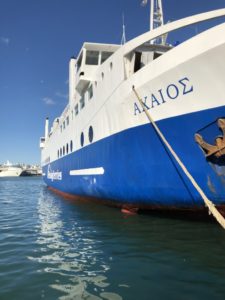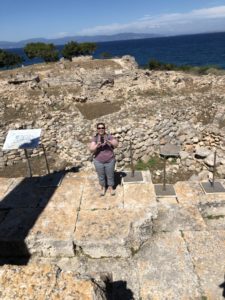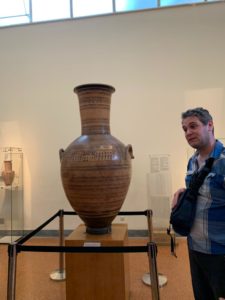 Today we went to two temples with the class. The trip began with an early bus ride to a ferry. The ferry was populated by a diverse collection of tourists including ourselves. As two people from coastline cities floating on the ocean was a comforting and familiar experience. Once we arrived on Agenia we bussed to a mostly ruined temple of Apollo. This aria was constantly used through the Neolithic and classical eras as a landmark of the island and is still recognizable by locals today as the temple of Apollo and a landmark of the city. The temple was surrounded by fortifications and evidence of previous settlements.
Today we went to two temples with the class. The trip began with an early bus ride to a ferry. The ferry was populated by a diverse collection of tourists including ourselves. As two people from coastline cities floating on the ocean was a comforting and familiar experience. Once we arrived on Agenia we bussed to a mostly ruined temple of Apollo. This aria was constantly used through the Neolithic and classical eras as a landmark of the island and is still recognizable by locals today as the temple of Apollo and a landmark of the city. The temple was surrounded by fortifications and evidence of previous settlements.
 Dr. Goldman stressed to the class how to look at these partially constructed ruins with imagination and integration of archeological knowledge giving insight into how they would have looked when they were regularly used and worshipped around. Due to the fact that there was one partially remaining pillar we had to reconstruct with our imagine the size and orientation of the temple. The temple was elevated from the surrounding buildings and while it would have have had fortifications as a temple to Apollo its main purpose was to be an icon of community values.
Dr. Goldman stressed to the class how to look at these partially constructed ruins with imagination and integration of archeological knowledge giving insight into how they would have looked when they were regularly used and worshipped around. Due to the fact that there was one partially remaining pillar we had to reconstruct with our imagine the size and orientation of the temple. The temple was elevated from the surrounding buildings and while it would have have had fortifications as a temple to Apollo its main purpose was to be an icon of community values.
The museum had a lot of art that was found locally at that site. Many of them were stele, grave markers, that had art that bore similarities to the naturalistic representations of Attica with island or regional influence. It was a trading port which means that it was also influenced by a host of Egyptian traditions that then found its way to Attica. So here we can clearly see cultural cross communication and imitation in artistic representations. Some of their art, unlike athenian art valued sea faring people enough to represent them alongside warriors. We were free at the end of the lesson to move around to other art and quietly mediation on it for a few minutes.
 The bus then took us to the temple of Aphaia, which was located father up on the island and not near the ocean. Before going into the site the group got pistachio gelato, which is apparently very popular in the area, at the shop nearby. The entire group took a photo at the temple after our examination. But before that we were taught about the different style of temple construction and the history of the theft of antiquities by German and British elites.
The bus then took us to the temple of Aphaia, which was located father up on the island and not near the ocean. Before going into the site the group got pistachio gelato, which is apparently very popular in the area, at the shop nearby. The entire group took a photo at the temple after our examination. But before that we were taught about the different style of temple construction and the history of the theft of antiquities by German and British elites.
As Dr. Kennedy discussed, for an important part of their history the German government and populous believed that they were the authentic dependents of the classical greeks because they could ‘truly’ understand classical literature, philosophy, and art, regarding the Greeks as morally declined and uninformed about their own culture. Today a large amount of art that should most likely reside in Greece lives in German and English museums, so the classical world bears a high degree of salience in the German consciousness. They exist there because German and English nobility took and stole antiquities to make their own museums extra fancy.
The temple of Aphaia at Aegina is the most intact ancient temple currently in existence to that god, the only one known about. It would be more intact if not for the European nobility that was previously mentioned, who stole a large portion of the pediment and took it back to Germany. As a result of this the site is actively impoverished on a daily basis due to its orphaned art. This is wicked sad.
It was very warm out at the sites but by the time we got to the beach it had cooled off and we could not enjoy the Aegina beaches. The food was interring, it had an excess of Garlic! on the plate, intact bones in fried seafood, and came with one of the best tasting lemons ever. This makes sense given that it is an island.
For dinner some of us bonded over the challenges of Denison while enjoying fried eggplant and feta cheese wrapped in philo dough, drizzled with honey. Some of us went clubbing while others tried to not pay for bottled water during dinner, somehow we were successful. Can’t wait to see what awaits tomorrow!
